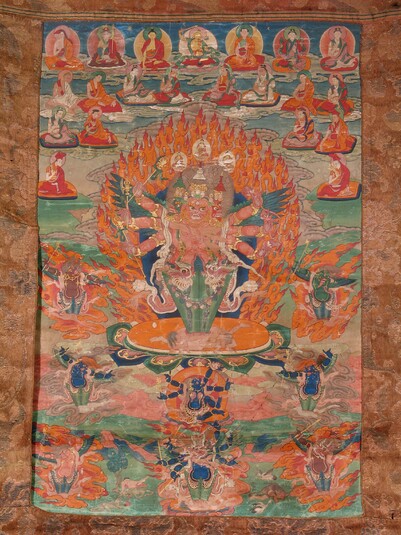
Item: Yamari, Rakta (Buddhist Deity)
| Origin Location | Tibet |
|---|---|
| Date Range | 1800 - 1899 |
| Lineages | Nyingma, Drigung (Kagyu) and Buddhist |
| Material | Ground Mineral Pigment on Cotton |
| Collection | Rubin Museum of Art |
Classification: Deity
Yamari, Krodharaja (kro rgyal g.shin rje'i g.shed. 'jam dpal kro chu dug gdong dmar nag): this meditational deity is a form of Manjushri but appears with many features of the deities Vajrakila and Guru Dragpur. The descriptive texts and rituals originate with the Nyingma 'Terma' Tradition of the Shang Trom Lineage. The practice was also popularized by the 5th Dalai Lama of the Gelug and follows the Drigung Kagyu Tradition of the practice from the Shang Trom line. Karma Chagme, of the Karma Kagyu, is a prominent 17th century figure in the line of the 2nd lineage of dissemination.
Wrathful in appearance, with three faces and six hands, he holds three axes in the right hands and hearts in the three left. The right face is green and the left face is red. Directly above the three faces are three stupas with the right and left matching the colours of the faces below and the central stupa white above the central red face. The Buddhas of the three Times are seated above the three stupas. Large blue wings are unfurled behind the upper torso. The lower body is in the shape of a kila, three bladed peg, with the point embedded into two prone corpses lying atop a sun and moon disc above a multi-coloured lotus blossom.
At the top center is the bodisattva of Wisdom Manjushri, along with Shakyamuni Buddha and Padmasambhava on the viewers left. Teachers of the Drigung Kagyu Tradition of Tibetan Buddhism fill out the upper half of the composition. The lower half of the composition is populated with eight retinue figures - attendants to the central deity.
This deity form is unique to Tibetan Buddhism in comparison with Indian Tantric Buddhist forms of Yamari. Close relationships with the Bon religion, indigenous to the Himalayas and Tibet, is directly indicated by the shared imagery of animal headed retinue figures and the use of symbolic stupas and Nirmanakaya Buddha figures above the heads. This type of construction is more commonly found with deities of the Bon religion.
Jeff Watt 2-2008 [updated 10-2012]
References:
- gshin rje gshed khro chu dug sdong nag po'i lsgrub skor/ 'bri gung bka' brgyud chos mdzod chen mo; W00JW501203, ff. 133v-182r (pp/. 268-364). [s.n.], [lhasa]. [2004].
Collection of Rubin Museum of Art: Painting Gallery 4
Tradition: Drigung Kagyu Main Page
Buddhist Deity: Yamari, Rakta, Main Page
Subject: Deities & Stupas
Buddhist Deity: Yamari, Rakta (Drigung)
Subject: Kila Lower Body




